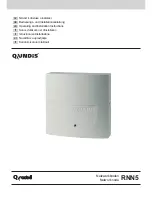
83
Glossary
Trunk: Transmission links that interconnect switching offices.
TSR (terminate and stay resident): A software program that remains active and in memory after its user interface is closed. Similar to
a daemon in UNIX environments.
Tunneling: Encapsulation data in an IP packet for transport across the Internet.
Twisted pair wiring: A type of cabling with one or more pairs of insulated wires wrapped around each other. An inexpensive wiring
method used for LAN and telephone applications, also called UTP wiring.
U
UART (Universal Asynchronous Receiver/Transmitter) (pronounced "you art"): A chip that transmits and receives data on the
serial port. It converts bytes into serial bits for transmission, and vice versa, and generates and strips the start and stop bits appended to
each character.
UNIX: An operating system developed by Bell Laboratories that features multiprogramming in a multi-user environment.
Unshielded Twisted Pair (UTP): Telephone-type wiring. Transmission media for 10Base-T.
V
V.25bis: An ITU-T standard for synchronous communications between a mainframe or host and a modem using HDLC or other
character-oriented protocol.
V.54: The ITU-T standard for local and remote loopback tests in modems, DCEs and DTEs. The four basic tests are:
• local digital loopback (tests DTE send and receive circuits),
• local analog loopback (tests local modem operation),
• remote analog loopback (tests comm link to the remote modem), and
• remote digital loopback (tests remote modem operation).
Virtual Circuit: A logical connection. Used in packet switching wherein a logical connection is established between two devices at the
start of transmission. All information packets follow the same route and arrive in sequence (but do not necessarily carry a complete
address).
W
Wide Area Network (WAN): 1. A network that provides communication services to a geographic area larger than that served by a local
area network or a metropolitan area network, and that may use or provide public communication facilities. 2. A data communications
network designed to serve an area of hundreds or thousands of miles; for example, public and private packet-switching networks, and
national telephone networks. Contrast with local area network (LAN).
Wide Area Telecommunications Service (WATS): A low-cost toll service offered by most long distance and local phone companies.
Incoming (800 call service, or IN-WATS) and outgoing WATS are subscribed to separately, but over the same line.
X
X.25: ITU-T's definition of a three-level packet-switching protocol to be used between packet-mode DTEs and network DCEs. X.25
corresponds with layer 3 of the 7-layer OSI model.
Y
Yellow Alarm: An error indication sent by the T1 device when it has not gotten a receive signal, or cannot synchronize on the receive
signal received. Contrast "Red Alarm" and "Blue Alarm".
Z
Zero Byte Time Slot Interchange (ZBTSI): A method for enabling 64K bps unrestricted user data (enabling all 0s in the user data). An
alternative to (but not as popular as) 8BZS.
Summary of Contents for MultiFRAD 200 Series
Page 1: ...Router Two Port Frame Relay Access Device MultiFRAD 200 Series Model FR2201 User Guide...
Page 5: ...Router Two Port Frame Relay Access Device Chapter 1 Introduction and Description...
Page 12: ...12 MultiFRAD II User Guide...
Page 13: ...Router Two Port Frame Relay Access Device Chapter 2 Installation...
Page 16: ...16 MultiFRAD II User Guide...
Page 17: ...Router Two Port Frame Relay Access Device Chapter 3 Software Loading and Configuration...
Page 25: ...Router Two Port Frame Relay Access Device Chapter 4 MultiFRAD Software...
Page 47: ...Router Two Port Frame Relay Access Device Chapter 5 Remote Configuration and Management...
Page 55: ...Router Two Port Frame Relay Access Device Chapter 6 Warranty Service and Tech Support...
Page 61: ...Router Two Port Frame Relay Access Device Appendixes...
Page 70: ...70 MultiFRAD II User Guide...
Page 71: ...Router Two Port Frame Relay Access Device Glossary...



































